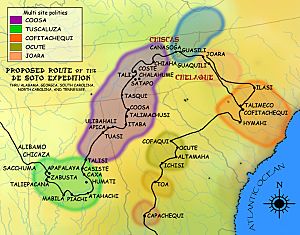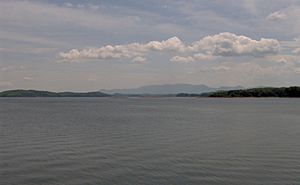Chiaha facts for kids
Chiaha was an important Native American chiefdom (a group of villages led by a powerful chief) in what is now East Tennessee. It was located in the beautiful valley of the lower French Broad River. The people of Chiaha lived in stable villages with raised homes. From their homes, they could see their fields of corn, beans, squash, and tobacco.
In the 1500s, Chiaha was the northernmost part of the powerful Coosa chiefdom. This was when Spanish explorers like Hernando de Soto and Juan Pardo traveled through the area. The Chiaha chiefdom covered parts of modern Jefferson and Sevier counties. It might have even reached into Knox, Blount, and Monroe counties.
The Spanish explorers wrote down what they saw in Chiaha. These writings give us a rare look at life in a Mississippian-era village. The Mississippian culture, especially the Dallas phase, was common in East Tennessee from about 1300 to 1600 AD. Both the de Soto and Pardo expeditions spent several days in Chiaha's main village.
The Pardo expedition even built a small fort nearby called San Pedro. This was one of five forts they built in the interior of North America. Sadly, most of Pardo's soldiers were killed by Native Americans in 1568. After this, the Spanish did not try to build more settlements in this inland area.
European diseases, like smallpox, caused many Native Americans to die. This led to big changes in how tribes were organized. The Cherokee and Creek tribes grew stronger in these areas. By the time English explorers arrived later, the Cherokee people lived in the Chiaha area.
Contents
Where was Chiaha located?
The main village of Chiaha was called Olamico by its own people. The de Soto expedition called it Chiaha, and the Pardo expedition called it Olamico. This town was on an island in the lower French Broad River. Today, this island is known as Zimmerman's Island.
Zimmerman's Island was about 33 miles (53 km) upstream from where the French Broad River meets another river. It was also about 1 mile (1.6 km) upstream from where Douglas Dam is now. When Douglas Dam was finished in 1943, it created a large lake. This lake completely covered Zimmerman's Island, so archaeologists can no longer dig there to learn more about Olamico.
Spanish Explorers Visit Chiaha
Hernando de Soto's Journey in 1540

In 1539, Hernando de Soto (who lived from about 1496 to 1542) led a Spanish expedition. He hoped to find a way to the Pacific Ocean and Asia across what is now the southeastern United States. De Soto's group landed in Florida in May 1539. They then marched north through modern Georgia and South Carolina.
In May 1540, they reached Cofitachequi, a very powerful chiefdom near modern Camden, South Carolina. The expedition continued north into North Carolina. On May 21, they arrived at a village called Xuala (now Joara). They also noted the Chalaque people nearby.
The explorers reached the start of the Toe River on May 26. They followed the Toe River to the Nolichucky River, and then followed the Nolichucky into modern Greene County, Tennessee. On June 4, while camping near the Nolichucky River, several Chiaha natives greeted them. They brought the Spaniards gifts of corn. The de Soto expedition arrived at Chiaha the next day, on June 5.
Chiaha was the first town de Soto's group saw that had strong wooden walls called palisades. The explorers wrote that the village was about 600 yards (550 m) from the eastern end of the island. The island itself was about 100 to 200 yards (90 to 180 m) wide. The river was wide on both sides but could be crossed. Corn was growing along the river banks across from the island.
The chief of Chiaha let de Soto use his house. At first, the villagers treated the explorers well. But after about two weeks, de Soto made the village elders angry. He asked them to give him thirty women for his expedition. The offended people quickly sent all the women away from the village. De Soto threatened to attack, and the people fled to a safe island further upstream. De Soto finally gave up his demand for women. Instead, he asked for people to carry supplies, which Chiaha agreed to provide.
On June 28, de Soto's expedition left Chiaha. They traveled west along the French Broad River to where it meets the Tennessee River near modern Knoxville. They continued along the Tennessee River to the village of Coste. This village was on Bussell Island at the mouth of the Little Tennessee River. The expedition followed the Little Tennessee River to the village of Tali. From Tali, they found a Native American trail that led them south to the Coosa chiefdom in modern northwestern Georgia.
While the Spanish were at Chiaha, the chief of Coste met with de Soto. He told de Soto about "yellow metal" mines about 30 leagues (90 miles or 145 km) to the northeast. This was in the land of the Chisca tribe. De Soto sent two of his men to investigate. They found only small amounts of copper, not the gold they hoped for. They said the land was very rough. The Spaniards returned in canoes given to them by the Chisca and rejoined the main expedition at Coste.
Juan Pardo's Expedition in 1567
In 1565 and 1566, Pedro Menéndez de Avilés wanted to expand the Spanish colony of La Florida. He started settlements at Saint Augustine in Florida and Santa Elena on Parris Island in South Carolina. In December 1566, De Avilés sent Captain Juan Pardo inland. Pardo's goals were to control the native people and find a route to the Spanish silver mines in Zacatecas, Mexico.
Pardo followed the Wateree River north into North Carolina. He eventually reached the village of Joara (which de Soto had called Xuala). Pardo built Fort San Juan at Joara. He explored the area nearby before being called back to Santa Elena. He left a group of 30 soldiers at Fort San Juan, led by Sergeant Hernando Moyano de Morales.
While Pardo was away, Moyano spent time looking for gold and jewels near Joara. In April 1567, he marched north across the mountains with 15 soldiers and some native allies. They attacked and destroyed a Chisca village in the upper Nolichucky valley. After a threat from a mountain chief, Moyano had to continue west down the Nolichucky River to the French Broad River. From there, they went to Chiaha on Zimmerman's Island. They built a small fort, San Pedro, near Chiaha's main village (Olamico). They waited for Pardo to arrive.
Pardo's second expedition started on September 1, 1567. He reached Joara in three weeks. After learning about Moyano's difficult situation, Pardo left Joara for Chiaha on September 29. Pardo passed through the Cherokee-speaking village of Tocae (near modern Asheville) on October 1. He then spent several days following the French Broad River across the Appalachian Mountains into modern Cocke County, Tennessee. He arrived at the village of Tanasqui (likely where the French Broad and Pigeon River meet) on October 6. He reached Chiaha the next day, October 7.
Pardo stayed at Chiaha for five days. Then he left for Coosa, which de Soto's expedition had described. He spent several days traveling through the foothills of the Great Smoky Mountains in modern Sevier and Blount counties. He reached the village of Chalahume in the Little Tennessee Valley. At the village of Satapo, Pardo was told that the Coosa chief was planning to kill him. So, he turned back. He passed through Olamico again on October 20 and left up the French Broad River on October 22. He arrived back at Santa Elena in February 1568.
Who were the People of Chiaha?
Chiaha was at the northern edge of the Coosa chiefdom's influence. This chiefdom stretched from Chiaha in the north to Talisi (near modern Childersburg, Alabama) in the south. Most villages Pardo visited were led by a local chief called an orata. But three villages— Chiaha, Joara, and Guatari— were each led by a major regional chief called a mico. (Some Muskogean-speaking tribes still used "mico" for "chief" even in the 1800s).
Micos were usually under the command of a paramount chief (a very powerful chief who ruled over many smaller chiefs). When de Soto visited, paramount chiefs lived at Cofitachequi and Coosa. But by Pardo's time, Cofitachequi's power had greatly decreased. The only known paramount chief was at Coosa, which Pardo did not visit because of a threat from its chief.
Life at Chiaha was probably typical for a Dallas-phase Mississippian village. The Mississippian culture began in Tennessee around 900 AD. This period marked a change for Native American tribes, as they became more complex farming societies. Mississippian people lived in or near large villages. These villages often had big, open plazas in the center. Around these plazas were one or more mounds used for religious and political events. The larger mounds, called "platform mounds", had public buildings on top. The Dallas culture also built special mounds for burials.
In 1940, archaeologists studied Zimmerman's Island before it was covered by the lake. They took pictures of a 30-foot (9 m) tall Mississippian-style platform mound near the eastern end of the island. Researchers have noted that the strong walls (fortifications) described by the Spanish at nearby Tanasqui were similar to those found at the Toqua site in the 1970s. These walls had square towers or bastions at different points. It's likely similar walls would have been found at Zimmerman's Island if it could have been dug up.
Like most Dallas-phase people, the Chiahans relied on corn for food. At Chiaha, de Soto and his men were given large amounts of sofkee (a thick corn soup like grits), honey, and a sweet sauce made from bear fat. The people also gathered wild fruits, like mulberries and grapes, which grew in the surrounding hills. The Chiahans stored their crops in raised storehouses, which the Spaniards called barbacoas.
The connection between the Mississippian people in the Tennessee Valley and the later Cherokee people has been a topic of discussion for a long time. Some people thought the Cherokee were direct descendants of the Mississippian people. However, based on language and archaeological findings, most experts believe the Cherokee, who speak an Iroquoian language, arrived later. They likely migrated from the Great Lakes area. They either took over the Mississippian villages or moved into them after they were abandoned.
In contrast, the Dallas-phase people of the upper Tennessee Valley (including Chiaha) spoke a Muskogean language called Koasati. This language is still spoken today by the Koasati tribe in Louisiana.
The writings of de Soto and Pardo show that Cherokee-speaking people lived alongside Mississippian Muskogean-speakers as early as the 1500s. Cherokee-speaking people lived in the mountains between Joara and Chiaha. One such village was Guasili, in the Nolichucky valley, which de Soto visited. While Pardo was at Joara, several Cherokee-speaking chiefs visited him. However, no Cherokee-speaking chiefs visited Pardo at Chiaha. The fact that Chiaha and Tanasqui were the only two fortified villages Pardo noted (besides the Chisca village Moyano destroyed) might mean that the people of Chiaha were at war with the Cherokee living in the mountains.
Several Mississippian town names recorded by Pardo were kept in some form by later Cherokee inhabitants. Examples include Citico (Pardo's Satapo) and Chilhowee (Pardo's Chalahume) in the Little Tennessee Valley. The name of the Cherokee capital of Tanasi, also in the Little Tennessee Valley, might have been influenced by the earlier village of Tanasqui, which Pardo recorded as just east of Chiaha. The village of Jore, a Cherokee Middle Town visited by colonist Alexander Cuming in 1730, may have been named after Joara.
More Places and People to Learn About



